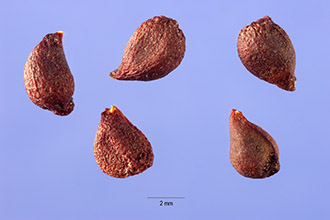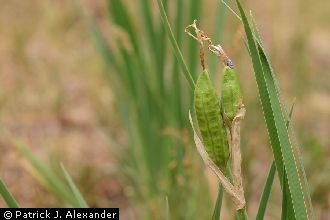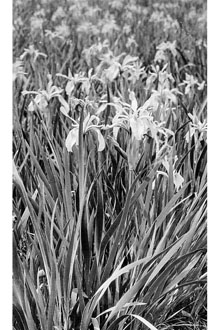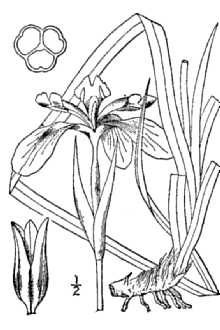Rocky Mountain Iris
Scientific Name: Iris missouriensis Nutt.

| General Information | |
|---|---|
| Usda Symbol | IRMI |
| Group | Monocot |
| Life Cycle | Perennial |
| Growth Habits | Forb/herb |
| Native Locations | IRMI |
Plant Guide
Alternate Names
Blue flag, flag lily, liver lily, water flag, snake lily, wild iris, lirio, Rocky Mountain iris
Uses
Warning: Fresh iris roots and rhizomes may be toxic. Ethnobotanic: Iris makes some of the finest cordage; the fibers are particularly strong and flexible. Iris cordage was used for fishing nets, string, rope, snares, hairnets, and regalia. These fibers are very fine and silky, but surprisingly strong. The threads and cords of this fiber were used to make fishing nets, camping bags and snares for catching deer, birds, and other game. In spite of the tremendous labor of preparing this material, the iris fiber was one of the most generally employed in northwestern California. Rope was made from fibers, which occur, on the outer margins of iris leaves. Huge bunches of leaves were harvested in the fall and stored until needed. A single silky fiber was taken from each margin of the leaf. None of the other fibers were used. The men always knotted the fishing nets. A deer rope is near 20 feet long with a lasso at one end, and about half an inch in diameter. This loop was set over a deer trail to catch the head or antlers. Within the set loop over the trail was spread a delicate network of the same material to draw in the loop. One Indian stated that "it takes nearly six weeks to make a rope twelve feet long." Alfred Brousseau © Brother Eric Vogel, St. Mary's College @ CalPhotos A poultice of the raw rhizome is especially effective against staph sores. Externally iris rhizomes are successfully used on infected wounds, ulcers, fistulas and to take away freckles. Only the dried iris root or rhizome should be used internally. Iris is active as a cathartic, has a stimulating effect on the production of both pancreatic enzymes and bile, is a strong diuretic, and will stimulate both saliva and sweat. This is a useful medicinal plant but in general should be used with care and preferably in combinations where less energetic plants forming the bulk of a medicinal formula. Landscaping & Wildlife: The beautiful and variable blossoms lend themselves to landscaping, where they naturalize and require minimal maintenance. Native irises are free flowering, most are long lived, require very little attention, and provide an abundance of seeds. Iris flowers attract both insects and hummingbirds. Invasive Potential: Western blue flag is considered a noxious weed in pastures, because leaves are unpalatable and bitter.
Status
Please consult the PLANTS Web site and your State Department of Natural Resources for this plant’s current status, such as, state noxious status and wetland indicator values.
Description
General: Iris Family (Iridaceae). Western blue flag is a perennial herb, usually evergreen and growing from a creeping, tuberous rhizome. Rhizomes on blue flag are between 20-30 mm in diameter, quite large for a native iris. The leaves are long and linear with parallel venation, 3-9 mm wide, and sometimes purplish. Stems are 2-5 dm and sometimes branched. Blossoms of Iris missouriensis are pale lilac to whitish with lilac-purple veins.
Distribution
For current distribution, please consult the Plant Profile page for this species on the PLANTS Web site, Use soil moisture sensors to measure the soil moisture of Rocky Mountain Iris.,
Establishment
The native irises are excellent in shade situations, even dense shade of walls and fences (Schmidt 1980). They will tolerate sun for most of the day in mild areas, and should have afternoon shade and ample water in the interior regions. These plants are intolerant of frequent summer water; they should not be planted near lawns or other moisture-loving plants. However, Iris missouriensis does need irrigation to get established. Fertilization increases biomass and seed production. Irises start growing with the first cool weather and fall rains, reaching the height of their growth in spring and early summer. This iris is rhizomatous, forms clumps, and propagates readily from plant division in fall or winter. Propagation by Plant Division: In the wild, Iris missouriensis tends to produce only a small, dry rhizome with stringy roots. Vigorous garden or greenhouse plants produce firm, white, growing roots especially during the winter and spring growing seasons, allowing easy division of clumps. Remove a new rhizome fan with fleshy roots and set it in a prepared site. Keep the newly planted rhizome watered so that it is moist, and provide shade for a few days if the plant is placed in full sun. Frequent division appears to keep the plants vigorous, as well as being the best method of increasing the supply. Propagation by Seed: Iris seeds are easily collected from the large capsules. These capsules turn from green to brown and open at the top when ripe. Care must be taken when handling seeds because they split very rapidly; two days after ripening the seed has spilled out. Collect capsules carefully to avoid spilling seeds; each capsule has from 20 to 80 seeds. Seeds should be stored in paper envelopes at room temperature until they are planted. The seeds of all species will keep up to 10 years at room temperature. Plant seeds in 6-inch pots, using a combination of leaf mold and peat moss. Cover seeds with 1/2 inch of same material. Any good potting soil that's acidic is good for seed germination. Keep soil moist but not wet. After planting, over-winter the pots outdoors in November or December. They will come up in 2-3 months, depending on the weather. Germination increases the second year, because there's always a percentage of hard seeds that won't germinate the first year. Delaying germination until the next year, to increase the probability for good weather conditions and optimize germination success enhances seedling survival. Plant the seedlings outdoors in May, when the young plants are usually 3 to 6 inches tall or even taller. Plants are likely to require watering the first year during roots establishment. Plant from 6 inches to one-foot spacing. If a natural look is desired, scatter and clump the plantings. Plants will begin to bloom by their second year if growth has been continuous. Direct seeding is possible in places that can be left undisturbed, as among shrubs, or among low perennials where the seedlings can be sheltered. If planting seeds in the ground, autumn is the best time for seeding; germination begins in two or three months and often continues beyond that time. A friable seed mixture of sand, loam, and either peat or screened leaf mold is best, covering the seed with sphagnum moss to aid in preventing damping-off of seedlings.
Management
In autumn, old leaves should be removed from the center of large clumps, the foliage cut back, and a mulch applied, especially if the irises are being naturalized in a semi-dry area. Traditional resource management included harvesting huge bunches of iris leaves in the fall, and storing these leaves until needed. The fibers are then harvested from the leaves. This naturally accomplished the pruning and mulching that modern horticulturists practice to maintain iris beds. The PCI borer (Amphipoea americana var. pacifica ) and iris borer (in the eastern U.S.) are serious pests of iris. The PCI borer stays in the rhizome through the winter, then metamorphoses, coming out sometime in the spring as a nocturnal moth. Controlling the moth, to prevent it from laying its eggs on the iris, will control the borer. However, it is recommended to dig infested plant out entirely, put it a plastic bag, and then place it in the garbage can to avoid contamination of other plants. Milkweed (Asclepias species) and dogbane (Apocynum cannibinum) were traditionally burned by native people in the fall to maintain vigorous plant production, to stimulate plant growth, to optimize long and abundant fiber production from leaves and stalks, and to stimulate seed production. It is probable that iris was burned for the same reasons. Cultivars, Improved and Selected Materials (and area of origin) IRMI is readily available through native plant nurseries within its rangeSeeds and plants of selected iris cultivars are available from many nurseries. It is best to plant species from your local area, adapted to the specific site conditions where the plants are to be grown. Contact your local Natural Resources Conservation Service (formerly Soil
Conservation
Service) office for more information. Look in the phone book under ”United States Government.” The Natural Resources Conservation Service will be listed under the subheading “Department of Agriculture.”
References
American Iris Society. SPCNI, Oakland, California. Archer, W.A. 1957. Abstract of pharmacological research. IN: Medicinal uses of plants by Indian tribes of Nevada, by P. Train, JR. Henrichs & W.A Archer, Pages 108-131. USDA, Plant Industry Station, Contributions Toward a Flora of Nevada, No. 45, Beltsville, Maryland [Facsimile Reprint: Quarterman Publications, Lawrence, Massachusetts, 1978.]. Cohen, V.A. 1967. Guide to the Pacific Coast irises. A monograph with drawings and photos. British Iris Society. This monograph has been reprinted by the Society for Pacific Coast Native Iris (SPCNI), 4333 Oak Hill Road, Oakland, California. Fowler, C.S. 1992. In the shadow of Fox Peak. An ethnography of the cattail-eater Northern Paiute people of Stillwater Marsh. Cultural Resource Series Number 5. USDI, FWS, Region 1, Stillwater National Wildlife Refuge. 264 pp. Hutchens, A.R. 1991. Indian herbalogy of North America. Shambhala, Boston & London. 382 pp. Lawyer, A. & L. (January/February) 1996. Growing and hybridizing your own iris. Growing native. The Newsletter of the Growing Native Research Institute. 15 pp. Martin, A.C., H.S. Zim, & A.L. Nelson 1951. American wildlife and plants: A guide to wildlife food habits. Dover Publications, Inc., New York, New York. 500 pp. Moore, M. 1979. Medicinal plants of the mountain west. Museum of New Mexico Press. 200 pp. Strike, S.S. 1994. Ethnobotany of the California Indians. Koeltz Scientific Books, USA\Germany. 210 pp. Warburton, B. n.d. The world of irises. American Iris Society, Tulsa, Oklahoma.
Plant Traits
Growth Requirements
| Temperature, Minimum (°F) | -28 |
|---|---|
| Adapted to Coarse Textured Soils | Yes |
| Adapted to Fine Textured Soils | Yes |
| Adapted to Medium Textured Soils | Yes |
| Anaerobic Tolerance | High |
| CaCO3 Tolerance | High |
| Cold Stratification Required | No |
| Drought Tolerance | Low |
| Fertility Requirement | Low |
| Fire Tolerance | High |
| Frost Free Days, Minimum | 115 |
| Hedge Tolerance | Low |
| Moisture Use | High |
| pH, Maximum | 8.5 |
| pH, Minimum | 7.0 |
| Planting Density per Acre, Maxim | 40000 |
| Planting Density per Acre, Minim | 1000 |
| Precipitation, Maximum | 35 |
| Precipitation, Minimum | 24 |
| Root Depth, Minimum (inches) | 6 |
| Salinity Tolerance | None |
| Shade Tolerance | Intermediate |
Morphology/Physiology
| After Harvest Regrowth Rate | Rapid |
|---|---|
| Toxicity | None |
| Resprout Ability | No |
| Shape and Orientation | Erect |
| Active Growth Period | Summer |
| Bloat | None |
| C:N Ratio | High |
| Coppice Potential | No |
| Fall Conspicuous | No |
| Fire Resistant | No |
| Flower Color | Purple |
| Flower Conspicuous | Yes |
| Foliage Color | Green |
| Foliage Porosity Summer | Porous |
| Foliage Porosity Winter | Porous |
| Fruit/Seed Color | Black |
| Nitrogen Fixation | None |
| Low Growing Grass | No |
| Lifespan | Short |
| Leaf Retention | No |
| Known Allelopath | No |
| Height, Mature (feet) | 1.0 |
| Growth Rate | Rapid |
| Growth Form | Colonizing |
| Fruit/Seed Conspicuous | Yes |
| Foliage Texture | Medium |
Reproduction
| Vegetative Spread Rate | Rapid |
|---|---|
| Small Grain | No |
| Seedling Vigor | High |
| Seed Spread Rate | Moderate |
| Fruit/Seed Period End | Spring |
| Seed per Pound | 19958 |
| Propagated by Tubers | No |
| Propagated by Sprigs | No |
| Propagated by Sod | No |
| Propagated by Seed | Yes |
| Propagated by Corm | Yes |
| Propagated by Container | No |
| Propagated by Bulb | Yes |
| Propagated by Bare Root | Yes |
| Fruit/Seed Persistence | No |
| Fruit/Seed Period Begin | Summer |
| Fruit/Seed Abundance | Medium |
| Commercial Availability | Routinely Available |
| Bloom Period | Spring |
| Propagated by Cuttings | No |
Suitability/Use
| Veneer Product | No |
|---|---|
| Pulpwood Product | No |
| Protein Potential | Low |
| Post Product | No |
| Palatable Human | No |
| Palatable Graze Animal | Low |
| Palatable Browse Animal | Low |
| Nursery Stock Product | No |
| Naval Store Product | No |
| Lumber Product | No |
| Fodder Product | No |
| Christmas Tree Product | No |
| Berry/Nut/Seed Product | No |



